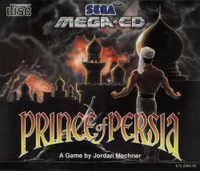| Prince of Persia | |

| |
| Developer(s) | Brøderbund |
| Publisher(s) | Brøderbund, Virgin games |
| Release date | 1989 |
| Genre | Third-person action, Adventure |
| Mode(s) | Single player |
| Age rating(s) | ESRB: T |
| Platform(s) | Apple II, DOS, Amiga, Atari ST, Sega Master System], Sega Mega-CD, Game Boy, Game Boy Color, NES, SNES, Amstrad CPC, ZX Spectrum, Game Gear, Genesis |
| Credits | Soundtrack | Codes | Walkthrough | |
Prince of Persia is a platform game that was released by Brÿ¸derbund in 1989.
It was widely seen as a great leap forward in the quality of animation seen in video games. Jordan Mechner, the author, studied many hours of films of his brother running and jumping in white clothes to ensure that all the movements looked just right in a process called rotoscoping. The game also featured an unusual method of combat. The protagonist and his enemies fought with swords, not some sort of projectile weapons, as was the case in most contemporary games.
Prince of Persia was released on a wide range of platforms, including the Amiga, Apple II, Apple Macintosh, DOS, NES, Game Boy, SNES and Sega Genesis. The game managed to surprise and captivate the player despite being, at first glance, repetitive.
As the title suggests, the game is set in Persia. The sultan is away at war, and the evil vizier Jaffar plans to seize the throne for himself. Jaffar has imprisoned the princess and given her one hour to make her decision: marry him, or die. The player assumes the role of an adventurer, the princess's true love. He must escape from prison and rescue her before the hour is up, defeating the vizier and earning the princedom of Persia.
[Reviewers speculate that the game's plot had its origin in several sources. The most obvious is the Arabian Nights, a series of traditional Persian stories translated into English by Sir Richard Francis Burton. Puccini's opera Turandot (1926) opens as the Prince of Persia is led to the executioner's block, having failed to guess the riddles. The title could also be a reference to a passage in chapter 10 of the Book of Danielin the Bible, which tells of the archangel Michael helping in a battle against a person referred to as the prince of Persia.]
The twist is that the game is played in real time, so the player must quickly complete the quest without breaks. On some platforms it is possible to save the game at the start of each level, however the time limit still applies. The only way to lose the game is by letting the time expire. If the player is killed, the game will restart from the beginning of the level, or in some levels, a mid-way checkpoint. The game also included a power bar. Medium falls, blue potions, sword hits and damage from falling platforms takes one notch from the power bar, while major falls, being hit unarmed, falling or running on spikes and blades kill the player instantly. The player can increase the number of notches in the power bar by drinking larger red potions, usually hidden or in dangerous places. There was also a green potion that made the player float or flip the screen, depending on the level.
Ports

NES cover
Originally released for the Apple II in 1989, Prince of Persia was ported to several other platforms. One year later it was ported to other personal computers such as the Amiga, the Atari ST, and the IBM PC Compatible. In 1992, when the home console market was growing steadily, versions for the Master System, Mega CD, NES, and Game Boy were released, as well as a version with enhanced artwork for the Apple Macintosh. A version for the SNES, with enhanced artwork and music, as well as new levels and expansion of the old ones, was also released. A Mega Drive/Genesis version followed in 1993. Another port was for the Gameboy Color six years later, in 1999. Java versions for mobile devices appeared in the early 2000s. For the revival title, Prince of Persia: The Sands of Time, the Macintosh version was put in to be unlocked by beating the game once or by finding a secret area (The Gamecube version of the game also has a third method of unlocking the original game by finding 3 switches in the Gameboy Advance game, with the GBA being connected to the Gamecube).
The SAM Coupÿƿÿ© version, released in 1992, is unique because it was programmed unofficially using graphics painstakingly copied pixel by pixel from paused frames of the Amiga version and only shown to Domark (the UK distributors of Prince of Persia) for potential release near completion. Although the computer had a very small user base and no other mainstream support, the release was allowed because of the very high quality of the conversion and the fact that it would incur almost no further development costs. Due to its independently produced status and the fact that the work was done almost entirely by one individual, Chris White, this version of Prince of Persia has several unique bugs.

|
This page uses content from Wikipedia. The original article was at Prince of Persia. The list of authors can be seen in the page history. As with Codex Gamicus, the text of Wikipedia is available under the Creative Commons Attribution-Share Alike 3.0 (unported) license. The content might also be available under the terms of the GNU Free Documentation License. |
